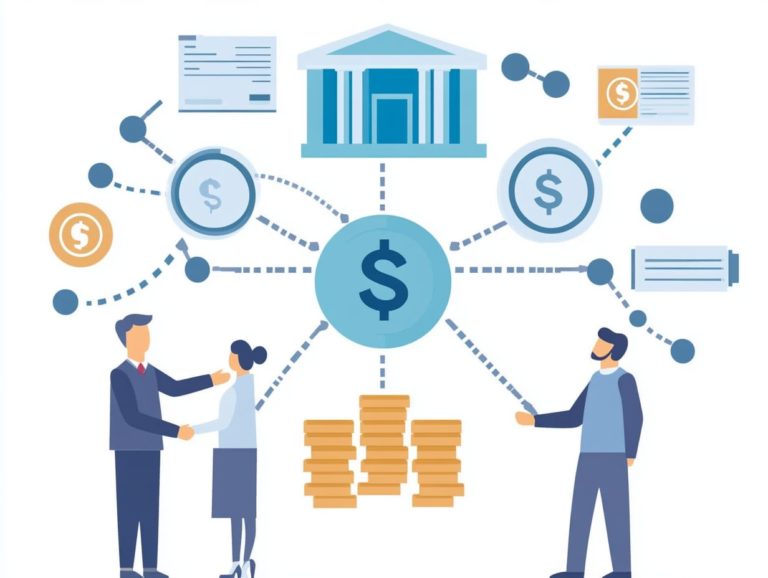Peer-to-Peer Lending: A Global Perspective
Peer-to-peer lending is revolutionizing how you access loans and invest your money! This groundbreaking method connects borrowers directly with investors and is changing the financial landscape in amazing ways.
You ll delve into the mechanics of peer-to-peer lending, its rich history, and its far-reaching global impact. The discussion will also include a comparison with conventional lending methods, highlighting both the benefits and risks, along with an overview of current regulations and emerging trends.
Engage with us to uncover the true potential of peer-to-peer lending.
Contents
- Key Takeaways:
- How Peer-to-Peer Lending Works
- The Global Impact of Peer-to-Peer Lending
- Benefits and Risks of Peer-to-Peer Lending
- Regulations and Future Outlook
- Frequently Asked Questions
- What is peer-to-peer lending and how does it work in a global perspective?
- What are the benefits of peer-to-peer lending in a global perspective?
- What are the risks associated with peer-to-peer lending on a global scale?
- How does peer-to-peer lending differ from traditional banking?
- Can anyone participate in peer-to-peer lending on a global scale?
- How is peer-to-peer lending regulated on a global level?
Key Takeaways:

- Peer-to-peer lending lets individuals lend and borrow directly, skipping traditional banks.
- The industry has seen rapid growth and is set to keep expanding.
- While there are benefits like lower rates, it’s essential to understand the potential risks and regulations involved.
Explanation of Concept and History
Peer-to-Peer (P2P) lending emerged in the early 2000s. It was created to address the limitations of banks, allowing you to connect directly with investors through online platforms.
This dynamic approach gives you the power to bypass the often cumbersome conventional loan processes and enables personalized loan terms that suit your needs.
With the rise of technological advancements like blockchain a secure way to record transactions P2P lending has evolved to offer you lower interest rates, higher returns on your investments, and greater access to capital, especially if you re a small business or an individual facing credit gaps. This shift reshapes how you see and engage with financial services.
Historically, the P2P lending model gained momentum with early platforms like Zopa in the UK and LendingClub in the US, which laid the foundation for a new era in personal finance. Key milestones include the 2005 launch of Prosper, the first U.S. peer-to-peer platform, which paved the way for widespread adoption and illustrated the legal landscape of peer-to-peer lending.
Economic shifts, such as the 2008 financial crisis, showed the weaknesses of conventional banking. This prompted many to seek alternatives, solidifying P2P lending’s critical role in today’s economy.
How Peer-to-Peer Lending Works
P2P lending is a simple yet powerful model. Individuals needing loans are matched directly with eager investors, making borrowing and lending much easier.
Step-by-Step Process and Participants
The step-by-step journey of Peer-to-Peer (P2P) lending begins with you, the borrower, submitting your loan request. From there, your creditworthiness undergoes rigorous assessment, helping to establish the interest rate that will apply to your loan.
Once you ve completed your application, lenders carefully review your request, considering factors such as the purpose of the loan and your credit history. The platform employs sophisticated algorithms to match you with suitable lenders, ensuring optimal terms for everyone involved.
While you focus on securing favorable rates and flexible repayment options, lenders are keen to grasp the associated risks, often seeking higher returns on their investments. With the integration of data analytics in P2P platforms, not only is the loan approval process streamlined, but the chances of successful matches also improve significantly.
This ultimately contributes to a more dynamic and vibrant lending marketplace.
The Global Impact of Peer-to-Peer Lending

The global impact of Peer-to-Peer (P2P) lending is huge! It has changed the finance landscape, providing millions access to funds who previously faced barriers from traditional banks, as highlighted in case studies from investors.
This is particularly evident in emerging markets, where financial institutions frequently struggle to meet the needs of the populace.
Growth and Development of the Industry
The growth and development of the Peer-to-Peer (P2P) lending industry have been significantly driven by technological advancements, giving power to platforms like Funding Circle and Kiva to create direct connections between borrowers and lenders around the globe. This model serves as an alternative to bank loans.
This evolution has not only expanded borrowers’ options but has also democratized access to credit. Now, individuals and small businesses that might have been overlooked by traditional banks can secure funding with greater ease.
Thanks to technological innovations like data analytics and machine learning, these platforms can assess creditworthiness with an accuracy that was previously unimaginable. This enhances risk management for lenders, giving you more confidence in the process!
The influx of venture capital into P2P lending has led to substantial market segmentation. This financial support fuels competition and encourages platforms to innovate continuously, resulting in niche services specifically tailored to your needs and enriching your overall experience.
Comparison to Traditional Lending Methods
When you compare Peer-to-Peer (P2P) lending to traditional lending methods, a few key differences really stand out, especially regarding interest rates, transaction fees, and how accessible capital is for borrowers.
These distinctions become even more pronounced as economic changes reshape the financial landscape. For instance, you might notice that today s borrowers often contend with stricter credit checks and higher fees from conventional banks, which drives many to consider alternative financing options.
In contrast, the P2P lending model offers lower interest rates thanks to its streamlined process and reduced overhead costs. You ll find that transaction fees are generally more favorable in this model, providing greater flexibility in repayment terms!
Such dynamics make P2P lending an appealing choice, particularly during economic uncertainty when individuals and small businesses are on the lookout for quicker and more affordable financial solutions.
Benefits and Risks of Peer-to-Peer Lending
While Peer-to-Peer (P2P) lending presents a wealth of advantages for both borrowers and investors, it is essential for you to understand the inherent risks associated with this alternative finance model.
This understanding will empower you to make informed decisions that align with your financial goals.
Advantages for Borrowers and Investors

P2P lending offers clear advantages for both borrowers and investors. Borrowers enjoy lower interest rates and better access to capital.
For investors, the appeal lies in the potential for higher returns on your investments. When you explore P2P platforms, you ll find that the streamlined application processes cut through the usual red tape of traditional loans, enabling quicker approvals and faster disbursements.
Plus, the flexibility in loan terms allows you to customize repayment plans that fit your unique financial situation perfectly!
For you, the investor, there s a diverse range of lending opportunities available, helping you manage risk while enhancing your portfolio. The prospect of higher returns becomes particularly enticing, especially since you can select loans that align with your risk tolerance, crafting a personalized investment strategy that works for you.
Potential Risks and How to Mitigate Them
Despite its many advantages, Peer-to-Peer (P2P) lending has risks, like potential defaults that may hurt your returns. This highlights the need for good risk management strategies and borrower protection mechanisms.
These risks primarily stem from the unpredictable nature of borrower behavior and economic fluctuations, which can lead to financial instability. You might face losses if borrowers default, making it essential to understand the level of risk you’re taking on.
To navigate these challenges successfully, conducting thorough credit assessments is crucial, as this enables you to evaluate the likelihood of repayment. Additionally, educating yourself on the nuances of the market will safeguard you against uninformed decisions.
Establishing borrower protection measures can create a healthier lending environment, ultimately benefiting everyone involved in the process!
Regulations and Future Outlook
The landscape of peer-to-peer lending is intricately shaped by evolving regulations designed to safeguard both borrowers and investors.
These regulations ensure a fair and transparent marketplace and promote innovation for a sustainable future.
By staying informed about these changes, you can navigate this dynamic environment with confidence. Make choices that align with your financial goals and ethical considerations.
Current Regulations and Predictions for the Future
Current regulations in the P2P lending space focus on your protection, emphasizing thorough checks on borrowers’ creditworthiness to maintain the integrity of the lending process.
To meet these objectives, a range of compliance requirements has been established. These mandates call for transparent disclosure of terms and conditions and rigorous vetting of lenders to prevent predatory practices.
Regulatory bodies are increasingly prioritizing the safeguarding of personal data, essential for maintaining your trust as a consumer.
Looking ahead, the industry may face tighter regulations as market participants push for standardized practices. Such changes could enhance your security as a borrower while influencing lender operations and investment strategies.
This evolving landscape could reshape the P2P lending experience for everyone involved. Stay informed and prepared!
Frequently Asked Questions

What is peer-to-peer lending and how does it work in a global perspective?
Peer-to-peer lending is a financial transaction where individuals or businesses lend and borrow money directly from one another without a traditional financial institution. This innovative model has seen significant growth, especially in Asia, as online services connect lenders with borrowers from different countries, highlighting the growth of peer-to-peer lending in Asia.
What are the benefits of peer-to-peer lending in a global perspective?
P2P lending allows greater access to financing for both lenders and borrowers, regardless of location. It offers potentially higher returns for lenders and lower interest rates for borrowers compared to traditional banking systems, making peer-to-peer lending an appealing option for investors.
What are the risks associated with peer-to-peer lending on a global scale?
Like any financial transaction, P2P lending carries risks. These include default risk, platform or currency risks, and regulatory risks. To navigate these challenges effectively, lenders should consult a beginner’s guide to understanding peer-to-peer lending and research these risks before participating globally.
How does peer-to-peer lending differ from traditional banking?
P2P lending eliminates the need for a bank as a mediator between lenders and borrowers. The process is entirely online, allowing direct communication and negotiation between the parties. Peer-to-peer lending usually has lower fees and interest rates compared to traditional banking.
Can anyone participate in peer-to-peer lending on a global scale?
P2P lending is available to a wide range of individuals and businesses, but certain requirements or restrictions may apply depending on the platform and country. For those interested in expanding their investment options, exploring real estate crowdfunding: a global perspective can provide valuable insights. Check with the specific platform and comply with necessary regulations before participating.
How is peer-to-peer lending regulated on a global level?
Regulations for P2P lending vary by country and usually fall under financial regulators. In some cases, platforms must obtain a license to operate and comply with rules to protect lenders and borrowers. Participants must know these regulations to enjoy a safe lending experience.






